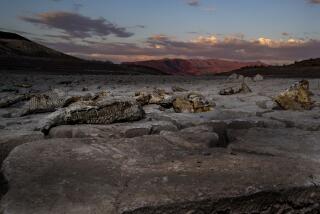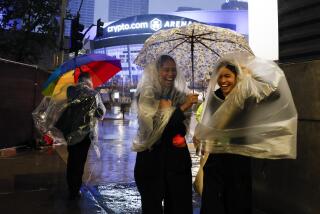Northwest’s Winter Drought Sets Stage for Long Summer
SEATTLE — In this winter of disturbing weather across the Pacific Northwest, Ken Hasbrouck looked toward the Cascade Mountains the other day and saw more bad news on the horizon: another brilliant, sunny, clear blue sky.
“I’d rather it would be miserable for a change,” said Hasbrouck, manager of the Kittitas Reclamation District, which serves roughly 1,300 farmers on the eastern side of the mountains. “We need the rain.”
Although Southern California has struggled with a deadly deluge of rain and mud this winter, much of the Pacific Northwest is experiencing the opposite -- a stunning lack of precipitation -- which prompted Washington Gov. Christine O. Gregoire to declare a statewide drought emergency Thursday.
Citing extremely low snowpack in the mountains and record-low flows on some major rivers, Gregoire urged residents across the state to conserve.
“We’re going to face a tough summer,” Gregoire said, “and there is not going to be enough water to go around.”
In some ways, winter has been an unexpected delight here -- the weather has been fine for sun worship, boating, backyard grilling and other activities generally associated with a Northwest summer. Views of both the Cascade and Olympic mountain ranges have often been spectacular.
Yet there is an ominous dearth of snow in those same mountains -- 20% of the average for this time of year in some places -- and officials warn of serious consequences. These include a higher risk of summer wildfires, river flows inadequate to protect salmon, major cutbacks in water allotments for farmers and higher electricity rates across the West.
If the severe shortage of precipitation continues into the summer, it could also ramp up the danger of blackouts in California, which depends on hydropower-generated electricity from the Northwest to meet the peak demand in those months.
The lack of snow has proved to be a disaster for ski areas in the Seattle region. Several have been closed nearly all winter, while others report a sharp falloff in patrons because the skiing is not very appealing. At one resort that remains open, Crystal Mountain, near Mt. Rainier, skiers contend with mud and dirt spots at lower elevations.
The drought is taking its toll on Washington, Oregon, Idaho and parts of Montana. Officials say that if there is no major break in the form of heavy spring rainfall, it could be the worst drought since 1977, when major conservation measures were enforced.
Meteorologists say the unusual weather patterns this year have pushed the rain southward.
“Basically, the L.A. area has gotten a lot of our rain,” said Guillemette Regan, strategic water advisor for Seattle Public Utilities, which serves 1.3 million people.
As for drinking-water supplies, the problem is not immediate. The combined reservoir storage for Seattle Public Utilities is at roughly 21 billion gallons, slightly above normal for this time of year because officials stored up a lot from heavy rains last fall. However, the capacity for the utility is 34 billion gallons, and officials say the low snowpack practically guarantees they will not get the level they want for summer. Farmers in some parts of the state have been warned that the low snowpack means they may get as little as a third of their normal allotments.
As has happened before -- perhaps most notably in Northern California and southern Oregon -- the fight over water could pit farmers against fish.
If the drought stretches through the summer, farmers probably will demand water from reserve areas that environmental officials will argue must be conserved to ensure healthy salmon runs along many of the Northwest’s big rivers.
Meteorology experts say that heavy rainfall this spring would help relieve a drought emergency, but few seem to think that is likely.
“This is very unusual weather, and it looks to be continuing,” said Cliff Mass, a professor of atmospheric sciences at the University of Washington.
The time for snow is running out, he said, and snowpack is generally a crucial source of water supply. “The snowpack looks to be at a record-breaking low -- the lowest in 50 years in some places,” he said.
Melting snow is normally a huge source of water supply here, used for everything from drinking water to the flows needed for hydroelectric production, irrigation and fish runs. But there is remarkably little snow to count on, and the snow season is rapidly coming to a close.
In King County, which includes Seattle and suburban and rural areas to the east, the Cedar River watershed is at 8% of normal. The Tolt River, which supplies roughly 30% of Seattle’s water, is at 23% of normal.
“They’re showing us areas where there’s normally 6 or 7 feet of snow, and there’s no snow at all,” King County Executive Ron Sims said after a helicopter tour. Sims said he would order the county to cut back on watering for landscaping and washing of county vehicles.
In Oregon, most river basins have one-fifth to one-third of the average rain and snowfall for the year, according to the Natural Resources Conservation Service, a federal agency.
Across the region, it has been a season for weather records or near-records related to dry and sunny conditions.
Spokane, with four-hundredths of an inch of precipitation last month, had the driest February since it began record-keeping in 1881. Seattle had its third-driest February on record, with 1.2 inches of rain -- which is 2 inches below average. Portland, with 1.3 inches of its average 4.18 inch rainfall, had its fourth-driest.
In Vancouver, British Columbia, officials are almost certain that the record for sunshine in February, set at 151.1 hours in 1968, was broken this year. They can’t say for sure, however, since they missed three days of record-keeping due to thieves taking the official sunshine-recording instrument the province uses.
In eastern Washington, Chelan and Douglas counties have reported about a dozen brush fires so far, and this at a time of year when there is usually snow on the ground.
Water-management officials, though concerned about the situation, say they have learned a great deal from previous droughts and have taken steps to mitigate the problem.
“We’re certainly in a below-average year for snowpack -- there’s no question about it. But we intend to meet our objectives” for water distribution, said Cindy Henriksen, chief of the reservoir control center for the U.S. Corps of Engineers in Portland. Henriksen monitors conditions for 25 Corps reservoirs as well as about 75 other municipal and private reservoirs.
“I’ve been working in water management for about 20 years,” she said. “In my tenure no two years are alike, and we may come out OK. But it would be better to have more water.”
Hasbrouck, the reclamation manager in Kittitas, said he had warned growers to expect as little as one-third of normal allotments this year, unless there was major rainfall in the coming weeks.
The dry weather has had at least one benefit -- allowing him to send out maintenance crews to work on pipe repair and other things that help water conservation in the hay-growing district.
“But right now, I’d much rather have to pay them to be inside,” he said.
“It’s basically getting too late to hope for snow, but we can still hope for some rain.”
More to Read
Sign up for Essential California
The most important California stories and recommendations in your inbox every morning.
You may occasionally receive promotional content from the Los Angeles Times.










